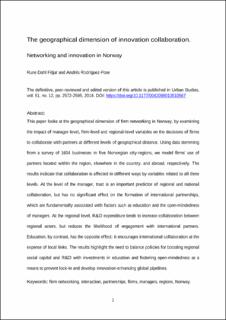The geographical dimension of innovation collaboration: Networking and innovation in Norway
Peer reviewed, Journal article
Accepted version
Permanent lenke
https://hdl.handle.net/11250/3042672Utgivelsesdato
2014Metadata
Vis full innførselSamlinger
Originalversjon
Fitjar, R. D., & Rodríguez-Pose, A. (2014). The geographical dimension of innovation collaboration: Networking and innovation in Norway. Urban Studies, 51(12), 2572-2595. 10.1177/0042098013510567Sammendrag
This paper looks at the geographical dimension of firm networking in Norway, by examining the impact of manager-level, firm-level and regional-level variables on the decisions of firms to collaborate with partners at different levels of geographical distance. Using data stemming from a survey of 1604 businesses in five Norwegian city-regions, we model firms’ use of partners located within the region, elsewhere in the country and abroad, respectively. The results indicate that collaboration is affected in different ways by variables related to all three levels. At the level of the manager, trust is an important predictor of regional and national collaboration, but has no significant effect on the formation of international partnerships, which are fundamentally associated with factors such as education and the open-mindedness of managers. At the regional level, R&D expenditure tends to increase collaboration between regional actors, but reduces the likelihood of engagement with international partners. Education, by contrast, has the opposite effect: it encourages international collaboration at the expense of local links. The results highlight the need to balance policies for boosting regional social capital and R&D with investments in education and fostering open-mindedness as a means to prevent lock-in and develop innovation-enhancing global pipelines.
